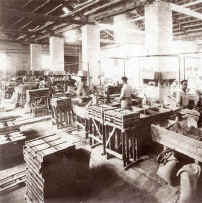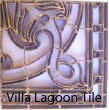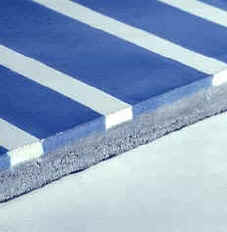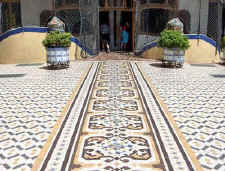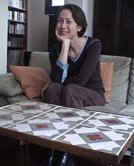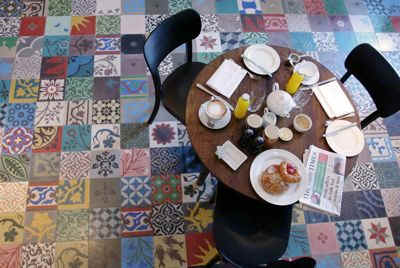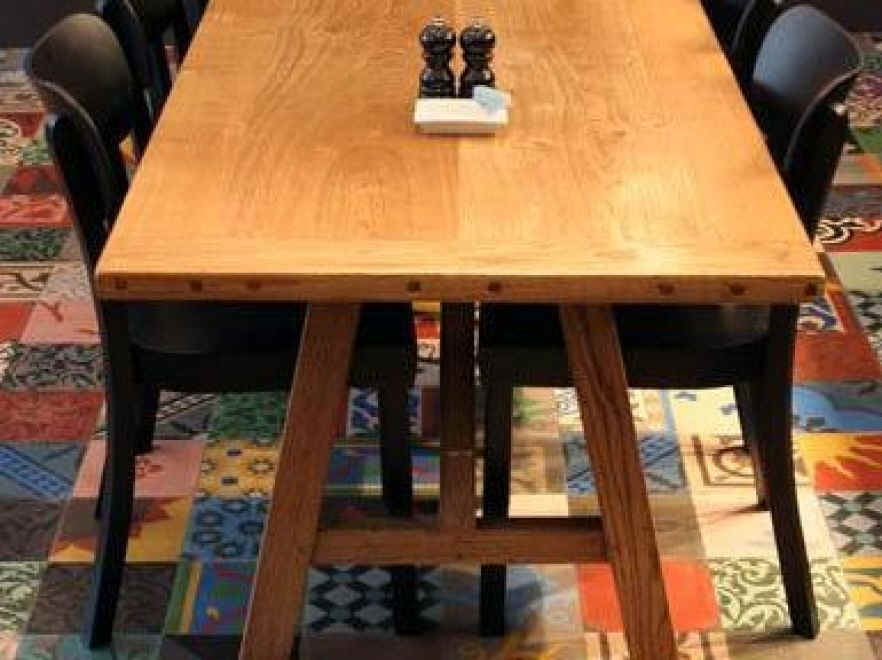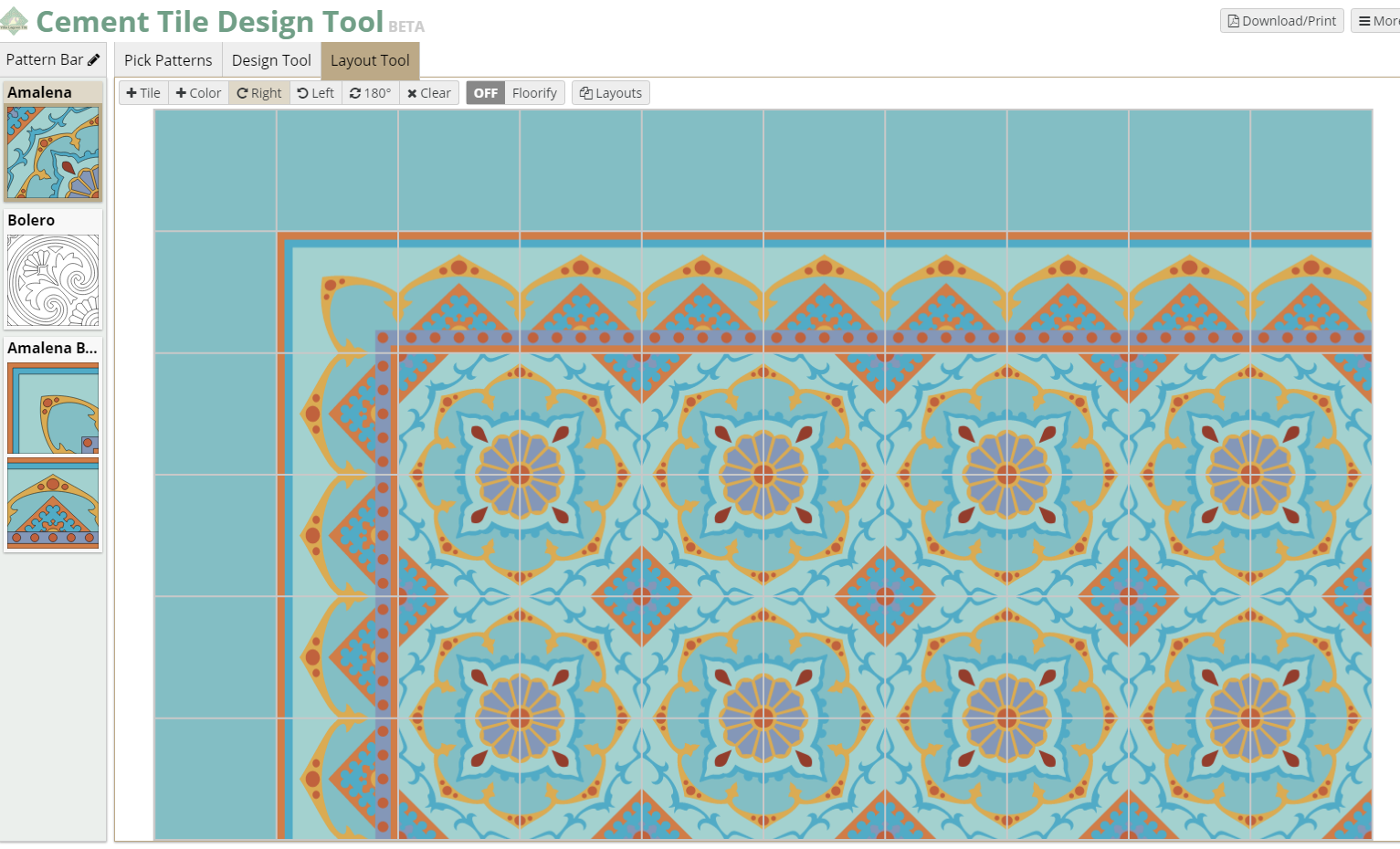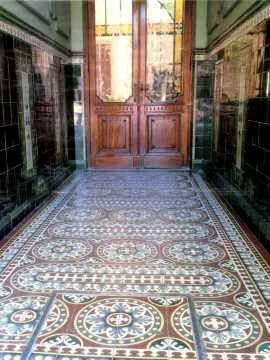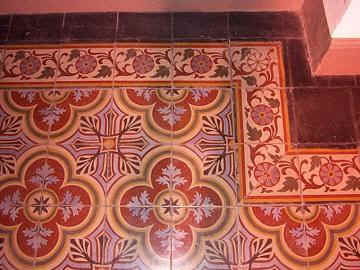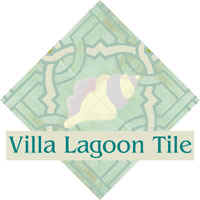

 www.ConcreteCottage.com
www.ConcreteCottage.com
Chronicles of the Design & Construction of Two Waterfront Hurricane Proof Dry Stack Modular Green Custom Homes
1. Villa Lagoon, Wilder Italian Style Home
2. Nasello Italian Style Home
Encaustic Cement Tile - Handmade Concrete Tiles
  |
  |
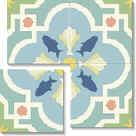  |
  |
Four encaustic cement tile designs from the Villa Lagoon Tile Collection... Three of the four are exclusive patterns.
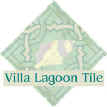 |
Look to Villa Lagoon Tile for Encaustic Cement Tile. The patterned mosaic tiles create fanciful floors and the tranquil solids. Bring back the old world charm of satin finish encaustic cement tile floors. Also Antique cement tile reproduction in USA. You can learn more about the history of cement tile, and reproduction projects on our encaustic cement tile reproduction page. |
Here you will fine the information on Encaustic Cement Tiles also called cement tiles, hydraulic floor tile, encaustic tiles, hidraulico, hydraulic tiles, ladrilhos hidráulicos, carreaux de ciments, Spanish mission tiles, mosaics de pasta, redondo tile, rajoles hidràuliques, baldosas hidráulicas, pasta potosi, hidraulicos antiguos, ladrilho de água, baldosas decoradas, mosaico hidraulico, mosaicos hidralicos, hidráulicas de cemento...and Tile Floor tile Layout Programs Online all gathered whilst researching this amazing floorcovering for use in our own hurricane-proof home.
After much consideration and research, I have decided that the best possible floors for this house are the old-fashioned Encaustic Cement Tiles. These durable, strong, colorful, patterned tiles have long been used around the world. They were manufactured in the States up thru the 30's and 40's and have been used in stately homes especially in California and Florida. So many cement tiles were imported from Cuba that down in South Florida they are called "Cuban Tile" . Worldwide, the terms that are used to describe this type of concrete tiles vary by region. Terms include: Cement Tiles, Hydraulic Floor Tile, Encaustic Tiles, Hidraulico, Hydraulic Tiles, Ladrilhos Hidráulicos, Ladril, Carreaux de Ciments, Spanish Mission Tile, redondo tile, Rajoles hidràuliques. Baldosas hidráulicas, Baldosa Hidraulica, Pasta Potosi Tile, mosaico calcareo and site surfacing product depending on the language and the country. They are still manufactured in many countries (See Below).
These classic tiles are still made outside the U.S. I have found evidence of workshops producing floor and wall tile in Brazil, Mexico, Spain, Dominican Republic, Turkey, Nicaragua and many other places. We have decided to order our tile from Villa Lagoon Tile. I prefer to conduct business in English as my foreign language skills are pretty limited.
History
Some say the original technique was developed in 18th century in Italy using natural colors of granite and marble dust and cement. According to one website, "the encaustic cement tile appeared at the end of the XIX century, in the south of France. Several sources say the first encaustic tiles were made in France near the country's first Portland cement plant. Until the 1920's, they were considered as high-end ultimate flooring that decorated the palaces of the Tsar, the mansions of the Côte d'Azure, Gaudi's Barcelona and Berlin's official buildings. Later on, the encaustic cement tile expanded as a creative and durable coating all over Europe, and the French, Spanish and Portuguese colonies. Around the 50's the Mosaic Hydralico lost importance and was replaced by less labor intensive, and less colorful floors. At the beginning of the 2000's , the trend for authentic products has brought back into fashion the encaustic cement tile.

It has never been possible to create an industrialized product that can substitute this handmade tile. The variety of colors, the matt finish and the soft silky texture are characteristics that make this tile absolutely unique. It is very important to note that no two tiles are exactly alike.
How Encaustic Cement Tiles Are Made
The tile maker creates a three part layered stack in a (usually) square mold. A sectioned pattern die is placed in the bottom of the open mold. Manufacturers put the color in the various sections first and then back the tile with other layers of cement products. The liquid color material is composed of ground marble dust, fine white Portland cement, and natural earth pigment. The stacked concrete tile layers are pressed using a hydraulic press and then removed from the mold. Generally the biscuit-like tiles are placed in a rack and submerged in water to allow the correct moisture necessary for the chemical reaction necessary to turn the tile into concrete. The tiles are removed from the water, allowed to dry and then stacked and allowed to age for some period of time for curing to achieve adequate hardness before shipment.
The end result is a tile that is usually about 5/8 inch thick (16mm) and quite heavy. One side is plain concrete and another side is a colorful tile.
The design layer is about 3 to 4 mm thick, giving the tile a great surface life, able to withstand all weather conditions and decades of traffic. Encaustic cement tiles can be found in many historic homes and public buildings throughout the world. Traditional cement tile is often used as ornamental motifs similar to carpets, bordered rugs, tapestries or mosaics.
This link has good pictures and video to show how encaustic cement tiles are made.
Encaustic cement is flooring with character, of great quality, outstanding for its clear, bright finishes, excellent ageing process, elegance and nobility.
This photo of roof tiles is one I took on a terrace at Casa Batlló in Barcelona, Spain. Casa Batlló is a private residence designed by Gaudi. It was built in the year 1877 and remodeled in the years 1905–1907. Look how well the tile has endured, even outside of a rooftop terrace, fully exposed to the elements.
Bénédicte Bodard collects hydraulic cement tiles from dumpsters of apartments being remodeled in Barcelona where she lives. She gives them a new life, a second chance as elegant table tops and trivets. See them at mesabonita.blogspot.com
This lively floor of mixed encaustic cement tile in the High Road House Hotel in the U.K. which designer Ilse Crawford calls a modern interpretation of brasserie tile. Order Patchwork Tile for USA, Canada & Caribbean or order Patchwork tile for the UK & Europe
Manufacturers of Encaustic Marble / Cement Tiles around the world:
If you know of others that are not listed, please email me with Encaustic Tile in the subject-line. If you have good photos I can add, also please email. [email protected]
USA
- Villa Lagoon Tile coastal themes, pastels, classic "Cuban Tile" & solid color tiles. Ships world-wide. www.VillaLagoonTile.com
Spain
- www.mosaicsmarti.com
- www.torrealmenara.es
- www.mosaicohidraulico.es
- www.huguetmallorca.com Huguet – Rajoles hidràuliques. Baldosas hidráulicas.
- www.mosaicstorra.com An all-Flash site, irritating, but they have great designs.
- www.pulidosbarcino.com A company who specializes in restoring and polishing hydraulic tiles. They did the floors at the famous Gaudi Casa Batlló. They have developed a mechanized polishing technique using abrasives to revitalize the original colors and tones of floors
- www.terrazosaljarafe.com Terrazos Aljarafe Another all flash website that is very annoying,w/ music (still in 2017) ....and difficult to navigate.
- www.ludivall.com Ludivall--Fábrica de Mosaico Artesanal--Toledo area of Spain.
- Balármoca - www.balarmoca.com see their photo gallery at Google's Picassa site, Mosaicos. I read that they are using the grandfather's old pattern molds once stored in a basement.

- www.mosaics.es Mosaic Art and Design--A Spanish site with many designs, traditional and moderne.
- www.pulidoscatalonia.com - refinishers of mosaico tile floors. Great before and after photos.
- www.terrazosaljarafe.com Spain very slow frustrating website
- www.solmosaicos.com , Soleras de Mosaicos, S.L., FÁBRICA DE LOSAS HIDRÁULICAS DE CEMENTO , Sevilla, Spain
- www.pulidosbaquedano.com restoration, maintenance.
- www.mosaicosartesanos.com Mosaicos Artesanos - fabrica losas hidraulicas para suelos o pared mediante un proceso manual y artesano. They just love these all flash sites with music. I don't. But they have a online floor tile design simulator.
- www.mosaicstorra.com Artesania--Highly annoying website is all flash, Mosaico, Mosaico hidraulico, Baldosa, Baldosas hidraulicas,
- www.mosaicospino.com Mosaicos Pino--Nice, fast loading website. But you wish you could enlarge the images. Download the pdf catalog. Classic patterns. En 1917 Jesús Pino Ramírez funda la fábrica de mosaicos hidráulicos de cemento para suelos que lleva su apellido.
Maó, Menorca
- www.pavimentostutzo.com Scroll to the bottom for more navigation choices.
Hungary
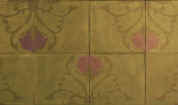
Great tile designs made by Szilvia Kauker. She wrote to me: "Since 2006 I run a small manufactory and have been designing and producing cement tiles. Your website is probably the best collection of cement tile manufacturers.
To make it complete I suggest you to list also my website as the sole cement tile manufacturer in Hungary. This craft was very popular in Hungary from 1890-1940, and also had small manufacturers until the 1970-1980. Since than all the manufactories had break off. I would like to revive this almost forgotten traditional technique and make it popular again in my country. I also trying to create our own unique style by introducing new patterns and special colour combinations." www.moza.hu
Indonesia
- http://www.yogyes.com/en/shopping/tile/diamond-baru-tile/
- http://www.yogyes.com/en/yogyakarta-tourism-object/places-of-interest/pabrik-tegel-kunci/
Canary Islands
- http://www.la-palma.de/artecuadrado/werkstatt.htm La Palma, Canary Islands...artsy tiles, site in German
Slovakia
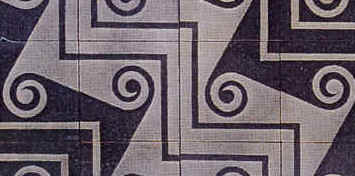
www.historickadlazba.sk Making historical tiles both interior cement tiles and exterior tiles.
Portugal
- Artevida www.artevida.net A mixture of classic and modern designs which yields a flexibility in design & colour combinations.Belgian & Irish founders, inspired by the local Alentejo arts, decided to stay in this beautiful region of Portugal, to help preserve these arts & to offer them new life.
- Lúcio José Oliveira Zagalo Telefone: 268081645 / 268322488 (Estremoz) Since 1941.
- Projecto Mosaico-- www.projecto-mosaico.com Projecto Mosaico Tiles are handmade floor and wall tiles. They are produced in Sintra, Portugal. In this region, as in the rest of Southern Europe, this type of tile goes back a long way in history and many old houses still have the original tile floors, often laid with chequer patterns or colourful motifs.
- www.azulejosantigos.com.br look under productos and the one in the drop down list.
- www.azulima.pt/mosaico_hidraulico.htm
- www.studiofirma.com Portuguese mosaic hydraulic (mosaic del sur), which makes artesanalmente
- http://www.castelo.com/ Arte do Cimento Castelo handmade Portuguese TILES - Loenen ad Vecht NL Handgemaakte Portugese tegels in honderden patronen en kleuren in Dutch.
- www.azulima.pt - cool designs not seen elsewhere
Italy
- www.recuperando.it many types of used and antique tile, including cement tiles.--RECUPERANDO
The Architectural Salvage Resource, Commercio all'ingrosso di materiali di recupero e accessori
Phone +39 0584 787016 fax +39 0584 786714, 55042 Forte dei Marmi (LU) Via G. B. Vico, 96 /A P.I.02067110466
Brazil
Brazil has many manufacturers of encaustic cement tile. In Brazil mosaicos hidráulicos are also called "ladrilho de água".
- http://www.hibrasil.biz/tiles/story.htm The Story of Pelotas Hydraulic Tiles
- http://www.ladrilhosaltense.com.br/
 www.ornatos.com.br - Large comprehensive beautiful looking website, made in Flash, so is a bit slow and
cumbersome. They have wonderful tile and one nice thing is if you click on an individual tile, you get an enlarged actual photo of a real tile, not just an artist rendering.
www.ornatos.com.br - Large comprehensive beautiful looking website, made in Flash, so is a bit slow and
cumbersome. They have wonderful tile and one nice thing is if you click on an individual tile, you get an enlarged actual photo of a real tile, not just an artist rendering.- www.dallepiagge.com.br and Houston TX ?? Go to the Catalog page and click Simulator... it is a very cool tool.
- www.br-imperial.com.br Wonderful looking tiles.

www.ladrilhosartesanais.com.br A nice website with inspiring photos of traditional mosaic cement tiles in residential and commercial settings. Making cement tile since 1922.- www.casafranceza.com.br Download the huge colorful catalog in .pdf format
- www.ladrilart.com.br
 www.ladrilhosaltense.com.br ;Not too much in the way of inspiring gallery photos, but obviously a supplier of standard cement tile with traditional patterns. For over 50 years in the tile and granilite business, working with quality, creativity and personalized customer service. Supplying all Brazilian states. Their work includes the restorations of floors of churches.
www.ladrilhosaltense.com.br ;Not too much in the way of inspiring gallery photos, but obviously a supplier of standard cement tile with traditional patterns. For over 50 years in the tile and granilite business, working with quality, creativity and personalized customer service. Supplying all Brazilian states. Their work includes the restorations of floors of churches.- www.portaldaspedras.ind.br this Brazilian Company makes cement tiles quite like the ones I saw when we lived in Costa Rica 30 years ago.
- www.gaudiladrilhoshidraulicos.com.br Great photos of the mold parts
- www.hibrasil.biz/tiles Pelotas Mosaic Tile Factory - tile rugs custom handcrafte
 Fabrica de Mosaicos - The Mosaic Factory was founded in 1914, amid the economic efervecência the city of Pelotas. Fabrica de Mosaicos in Brazil has an all Flash website which includes traditional cement floor tile, esp. nice florals. They encourage us to create a 'tapete de ladrilhos!' using their online tile layout program. They have an online tile layout tool that will allow you to play with colors in the tile as well as tile combinations.
Fabrica de Mosaicos - The Mosaic Factory was founded in 1914, amid the economic efervecência the city of Pelotas. Fabrica de Mosaicos in Brazil has an all Flash website which includes traditional cement floor tile, esp. nice florals. They encourage us to create a 'tapete de ladrilhos!' using their online tile layout program. They have an online tile layout tool that will allow you to play with colors in the tile as well as tile combinations.- www.ladril.com They offer some vivid and bold floor tile designs.
- www.adagostini.com.br a moldmaker, I emailed him but got no reply.
- Imprec Preblok - http://www.prebloc.com.br/ Several types of traditional tile plus outdoor pavers.
- www.ladriminas.com.br delightful website with many photos, large collection of tile designs, and much information, it uses Flash, but is not difficult to navigate.

Dalle Piagge - Armazém Cerâmico Dalle Piagge offers a wide variety of graphic patterns of different influences in their ladrilho hidráulico.
Azulejos Antigos This comprehensive Brazilian company offers tile of all types and includes Ladrilhos Hidráulicos in traditional florals and geometrics.
Uma fabrica de ladrilhos hidráulicos situada em Americana, São Paulo, Brasil. Nice tile designs in many sizes. An all Flash website, a bit slow to load here in the US. www.mosaika.com.br
Argentina
- www.companiadepisos.com.ar An Argentina company says they have been making these cement encaustic tiles since 1896. This Flash website is a joy to behold, slow loading but clever artwork.
- www.mosaicoscurti.com.ar - Mosaics Curti - This company founded in 1934 has extensive experience in the manufacture of floor tiles and mosaics. The facilities are located in Vicente Lopez, Buenos Aires , Argentina.
Venezuela
 Renato Andrade - He and his father have been making cement tile for 30 years. He is experimenting with large cement tile, 60cm por 30cm. Si es un formato experimental de 60cm por 30cm,estamos tratando de innovar y experimentar con este maravilloso arte que es la fabricacion de azulejos y el contacto directo con mi empresa es atraves de mi persona. Maracaibo, Venezuela .Click to see the large format cement tile. [email protected]
Renato Andrade - He and his father have been making cement tile for 30 years. He is experimenting with large cement tile, 60cm por 30cm. Si es un formato experimental de 60cm por 30cm,estamos tratando de innovar y experimentar con este maravilloso arte que es la fabricacion de azulejos y el contacto directo con mi empresa es atraves de mi persona. Maracaibo, Venezuela .Click to see the large format cement tile. [email protected]
France
- http://www.lesterrescuites.com/carreauciment/intro.htm
- www.mosaika-creation.com
- www.139inclusions.free.fr Artistic floors with inclusions of metal strips and tiles. Stone floors cement, stone floors of cement inlaid with mosaic. Carreaux ciment, carreaux de ciment incrustés de mosaïque.
- www.couleurs-et-matieres.fr A fun pdf catalog that shows whimsical designs as well as classic cement tile looks. French company, tiles are made in Vietnam.
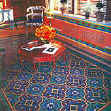 www.carocim.com Begun in 1986. Christian Berthéas, educated at the Beaux Art and Arts Décoratifs Faculties in Paris, went to Marrakech to work on an architectural project. Here he was amazed and fascinated by the beauty of the cement tiles. He found that architects from Marseilles , who had emigrated there around 1910, had originally designed these tiles. After his return to France in 1986 Christian Berthéas launched Carocim Company. In 1990 Martine Murat, a talented painter and decorator educated in New York and Paris, joined Carocim . Together they have been recreating the sumptuous designs of the past as well as totally new ones. Their catalogue presents over 350 models with a range of 18 colors.
www.carocim.com Begun in 1986. Christian Berthéas, educated at the Beaux Art and Arts Décoratifs Faculties in Paris, went to Marrakech to work on an architectural project. Here he was amazed and fascinated by the beauty of the cement tiles. He found that architects from Marseilles , who had emigrated there around 1910, had originally designed these tiles. After his return to France in 1986 Christian Berthéas launched Carocim Company. In 1990 Martine Murat, a talented painter and decorator educated in New York and Paris, joined Carocim . Together they have been recreating the sumptuous designs of the past as well as totally new ones. Their catalogue presents over 350 models with a range of 18 colors.- www.antiques-forain.com lots of pictures of styles, no info about ordering except the contact page.
- http://www.carrelagesdumarais.com seems to be a dealer that carries cement tile made in North Africa.
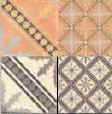
www.emauxdelafontaine.com - not sure if manufacturer or a showroom.I see they make or carry several types of tile.
Germany
- VIA Finest Tiles - Very slow loading for me. Pretty basic tile designs.
 MOSAICO Fliesenmanufaktur - This site is in German. If you fish around a bit, you can change the site to English. I did. Click on "Sprache" and chose a language, then look at the page called "Production" for some nice photos of a cement tile being made. This is a nice quick loading website w/ good solid content. Would you expect anything else from Germans? Look at the patterns, the florals are exquisite and this is a huge range of wonderful designs.
MOSAICO Fliesenmanufaktur - This site is in German. If you fish around a bit, you can change the site to English. I did. Click on "Sprache" and chose a language, then look at the page called "Production" for some nice photos of a cement tile being made. This is a nice quick loading website w/ good solid content. Would you expect anything else from Germans? Look at the patterns, the florals are exquisite and this is a huge range of wonderful designs.
Netherlands
- Arte do Cimento Castelo handmade Portuguese Tiles - Loenen ad Vecht NL Handgemaakte Portugese tegels in honderden patronen en kleuren in Dutch.

Tegel BV--Nice online Flash catalog with turning pages. They have good photos of installations and graphics of suggested floor color schemes. Many are two-toned and quite handsome and contemporary looking. These tiles are actually made in Morocco. http://www.tegelbv.n
Morocco
- www.mosaicohidraulico.com Art et Ciment - Gran Fabrica de mosaicos hidráulicos, Fabricantes de mosaico hidráulico also atwww.artetciment.com Both sites are down now.
- Sahara Designs can provide you with exquisite handmade Moorish tile and Moroccan decor
- Rajae Ouechkifi, Address: Abderrahman Kaouakibi, Tangier, Tangier, Morocco (Morocco)
- www.abacoarte.com Located in Spain but imports tile from Morocco, may not be Spanish quality
- www.andaluciamosaic.net - Imports into Spain from Morocco. They offer 400 patterns of tiles or 400 modelos de baldosas hidráulicas.
- www.mosaicdecor.net also www.mosaicdelsur.com Mosaic del Sur is maintaining a Spanish business office but they import from Morocco. A traditional cement tile manufacturer that works with over 400 patterns and a 36-colour palette creating authentic floors identical to those used throughout Europe during the first half of the last century.
- http://www.zelart.com/es/muebles/baldosas.htm
Mexico
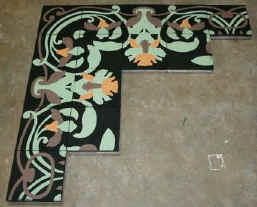 Hacienda Studio--A very old family operation now combined with a Texan partner. They have some fabulous old mold patterns that take up to 13 separate tiles to create the elaborate and Art Nouveau-ian style borders. Michael Moss has wonderful facilities to produce high quality tiles. Located in Central Mexico near Mexico City. Michael Moss wrote to us: HELLO- THANK YOU FOR PROVIDING SUCH A WONDERFUL SITE TO VIEW SO MUCH WELL ORGANIZED INFORMATION ON MOSAICOS-- MY NAME IS MICHAEL MOSS- I LIVE IN TEXAS AS WELL IN MEXICO- I OWN A MOSAICO TILE FACTORY IN MEXICO --MY WEBSITE IS - www.haciendastudios.com I SHOW ABOUT 30 DESIGNS ON THE WEBSITE - ALTHOUGH I NOW HAVE A ARCHIVE OF 100 DESIGNS- I HAVE SOME THAT TAKE UP TO 13 MOLDS TO CREATE A DESIGN- IT IS AN ART NOVEAU PATTERN THAT I BOUGHT FROM A 90 YR OLD WOMAN WHO HAD IT MADE FOR A PROJECT IN THE 40'S FOR A HOTEL IN MEXICO -I WILL ATTACH IT IN ANOTHER EMAIL, FOR YOU TO SEE YOURSELF- I HAVE OPERATED FOR 8 YEARS IN PATZCUARO, MICHOACAN- MEXICO- I AM CONSIDERING MOVING MY OPERATION TO TEXAS TO SAVE ON SHIPPING COSTS- OR I MIGHT JUST OPEN ANOTHER EXTENSION OF THE BUSINESS ALREADY IN MEXICO-IF THERE IS ANYTHING I CAN DO TO HELP YOU OR TO PROVIDE YOU MORE INFORMATION - PLEASE FEEL FREE TO CONTACT ME ANYTIME AND IT WOULD BE A PLEASURE FOR ME -- I SEND YOU MY BEST REGARDS AND THANKS FOR YOUR LOVE OF SUCH A BEAUTIFUL PRODUCT -www.haciendastudios.com
Hacienda Studio--A very old family operation now combined with a Texan partner. They have some fabulous old mold patterns that take up to 13 separate tiles to create the elaborate and Art Nouveau-ian style borders. Michael Moss has wonderful facilities to produce high quality tiles. Located in Central Mexico near Mexico City. Michael Moss wrote to us: HELLO- THANK YOU FOR PROVIDING SUCH A WONDERFUL SITE TO VIEW SO MUCH WELL ORGANIZED INFORMATION ON MOSAICOS-- MY NAME IS MICHAEL MOSS- I LIVE IN TEXAS AS WELL IN MEXICO- I OWN A MOSAICO TILE FACTORY IN MEXICO --MY WEBSITE IS - www.haciendastudios.com I SHOW ABOUT 30 DESIGNS ON THE WEBSITE - ALTHOUGH I NOW HAVE A ARCHIVE OF 100 DESIGNS- I HAVE SOME THAT TAKE UP TO 13 MOLDS TO CREATE A DESIGN- IT IS AN ART NOVEAU PATTERN THAT I BOUGHT FROM A 90 YR OLD WOMAN WHO HAD IT MADE FOR A PROJECT IN THE 40'S FOR A HOTEL IN MEXICO -I WILL ATTACH IT IN ANOTHER EMAIL, FOR YOU TO SEE YOURSELF- I HAVE OPERATED FOR 8 YEARS IN PATZCUARO, MICHOACAN- MEXICO- I AM CONSIDERING MOVING MY OPERATION TO TEXAS TO SAVE ON SHIPPING COSTS- OR I MIGHT JUST OPEN ANOTHER EXTENSION OF THE BUSINESS ALREADY IN MEXICO-IF THERE IS ANYTHING I CAN DO TO HELP YOU OR TO PROVIDE YOU MORE INFORMATION - PLEASE FEEL FREE TO CONTACT ME ANYTIME AND IT WOULD BE A PLEASURE FOR ME -- I SEND YOU MY BEST REGARDS AND THANKS FOR YOUR LOVE OF SUCH A BEAUTIFUL PRODUCT -www.haciendastudios.com- Mosaicos La Peninsular - Merida - Mosaicos de Diseño located in San Luis Potosi, Mexico

Mosaicos El Gallo, founded in 1935. Mission tile. Craftman's perfection. Durable marble/cement based, fully handmade, work of art. Select from several colors and shapes or make a style of your own. Ideal for pubs, homes and public buildings. Mostly the swirly marble-y type of cement tile.Aramberri No. 1445 Pte., Monterrey, N.L., México- Fabrica de Mosaicos Santa Ines--Vera Cruz, website not working but Vera Cruz was hard hit by a hurricane in 2007. Carretera Transistmica 11 - Cosoleacaque - VeraCruz
- Art y Decortion--Oxaco, Calle Violetas 213, Reforma, 68050 Oaxaca, MX
Kathleen Harvey who lives in Mexico has written to me: "My cleaning lady back in the seventies showed me how she looked after the floors: When wet mopping, apart from the usual Ajax liquid (or similar) she added about half a cup of "petroleo" (mineral oil) to the water. To keep the floors shiny she "massaged" a mixture of paste wax and mineral oil into a cotton dust mop and dusted the floors with this a couple of times a week. I haven't been able to find any references to this material here in Mexico. I had the floors here repolished with oxalic acid..The tiles were normally originally buffed, when first installed, with oxalic acid and then "tierra inglesa" which I think is similar to ceriul (used for glass polishing)." She also says that in Mexico the color layer on the tiles may not be as thick as those made elsewhere. Some of her's have worn thru in doorways, but then she is talking about a 100 year old home.
I feel sure there may be more cement floor tile manufacturing plants in Mexico, they may not have websites.
Philippines
- Habitiles Baldozas y Azulejos de Cemento - Baldozas y Azulejos de Cemento. Lovely patterns, Islamic influenced patterns as well as antique tile designs from Spain and other European countries.
- Machuca Tile in Philippines www.machucatile.com - oldest tile manufacturing business in the Philippines. Baldozas mosaicos made there are now known as Machuca Tile. The business was originally called Mosaicos Machuca. Traditional patterns and colors.
India
- http://www.royaltiles.com/boutique.htm 905/906, Aalap-A, 9th Floor,Limbda Chowk, RAJKOT-360 001 ( INDIA ), Tele. (+91) 0281 - 2482868 / 2481374., Fax : 91-281- 2466054.
- http://www.tilesforoutdoor.com/athangudi.htm - Athangudi floor tiles from Chettinad, India--Athangudi tiles, named after the place in Chettinad, Tamil Nadu, where they are manufactured, come in myriad colours and patterns and are made by a unique process, using local soil. These tiles are testimony to the rich cultural heritage of the Chettiars, who traded extensively in the days of yore, especially with Burma. The Chettiars effectively adapted many an influence, to their own brand of local craftsmanship. The designs and colours used in Athangudi tiles are still those of a bygone era.
Bali
- http://www.sadustiles.com/ Made in Bali with a beautiful palette.
Vietnam:
- www.couleurs-et-matieres.fr A fun pdf catalog that shows whimsical designs as well as classic cement tile looks. French company, tiles are made in Vietnam.
- Thanh Danh Cement Tile- TDC is planning to expand their production line of 50 cement tile presses with the capacity to produce 12000 cubic meters per month. This company makes traditional encaustic cement tile in the 'French tradition' according to the web site. In addition to the simple geometric and traditional mosaic designs, this company has some contemporary whimsical floral patterns. (website down 8-30-2009)
Turkey


- EROL TAYMAZ Cement Tiles--no main website located, mentioned in several world trade category sites.
Iran
- Siman Tile, 60 Nasibi St. -Valiasr St. -, Tehran, Tehran, Iran (Islamic Republic of) - according to the international trade website that lists them, "Siman Tile" produces high quality Cement Tiles in a diverse variety of designs,sizes and colors for any need and taste.
Greece
- For three million Euros you can buy a whole cement tile manufacturing plant it seems.
Chile
- www.baldosas-super.cl Looks like an interesting website, but it is highly irritating the way the all Flash site opens without a toolbar and full screen is the only option. Many illustrated baldosas.
Italy
- www.pisamarmi.com.it Unable to reach a website here, but it is mentioned by others.
Costa Rica
I found a list of what might be mosaicos hidráulicos cement flooring tile plants in Costa Rica but no websites. Some of them might just make plain tiles. I once lived in Costa Rica and laid heavy, large solid color reddish encaustic tiles on a 20 x 20 ft. concrete slab that were made in the Limon area. My husband went after them in our pickup and the weight was almost too much to get back with.
- Mosaico Doninelli S.A. Mosaic Doninelli SA, Desamp, San Jose
- Fabrica de Terrazos Escama y Alvarez Ltda. Fabrica de Terrazos scale and Alvarez Ltda., Sn Fco de Dos Ríos, San Jose
- Fabrica de Terrazos Costa Rica Escama & Alvarez Ltda. Fabrica de Costa Rica Terrazos Luska Alvarez & Ltda.Sn Fco de Dos Ríos, San Jose
- Fabrica de Terrazo y Paladiana Oscar Solera Fabrica de Terrazo and Paladiana Oscar Solera, San Miguel Desamp
- Fabrica de Terrazo y Mosaicos Don Bosco S.A. Fabrica de Terrazo and Mosaics Don Bosco HS, Tejar El Guarco, CARTAGO
- Fabrica de Mosaico y Terrazo El Castillo Manufactures of Mosaic and Terrazo Castle, Bo Sn José Alajuela, Alajuela
- Solobloc, Apdo 90-2250, Tres Rios, Costa Rica
- Pisos Honey Telefono : (506) 441-3944, 1 km Oeste Aerop Juan Santamaría, Autopista Bernardo Soto, San José, Costa Rica
- Pavimientos Creta S.A., Telefono : (506) 4282-2873, Fax : (506) 282-2873, Celular : (506) 396-6608 Santa Ana - Brazil de Mora, San José, Costa Rica
- Mosaicos Doninelli, Telefono : (506) 250-6070, Fax : (506) 259-3333, Apdo 5287-1000, San José, Costa Rica
- Mejías, Telefono : (506) 433-8696, Fax : (506) 433-8696, 100 m norte del club de Leones, Barrio San José, Alajuela, Costa Rica
- Maca, Telefono : (506) 237-2882, Fax : (506) 237-6966, Apdo 122-3000, Heredia, Costa Rica
- Decantera, Telefono : (506) 203-3690, TeleFax : (506) 282-7654, Centro Comercial Tejas del Sol, 500 m Este de la Cruz Roja, Santa Ana - Costa Rica
- Castillo (el), Telefono : (506) 433-8110, Fax : (506) 433-3813, Pedidos : (506) 380-2825
- Barrio San José de Alajuela de la Iglesia, 100 m al oeste, Alajuela, Costa Rica
- Alajuelense (la) Telefono : (506) 244-0809, Fax : (506) 244-0809, Santo Tomás de Santo Domingo de Heredia, 100 m al este de la Iglesia, San José, Costa Rica
Honduras
- Industrias Germania--Tegucigalpa, Honduras , Regi Gonzalez [email protected], tel. +(504)9688-8656
Peru
Belgium
- Emery et Cie - Very Special !!! A MUST SEE SITE. Their tile is made in Morocco.
- Westvlaamse Steencentrale they sell tegels, which is cement floor tiles I think.
If you know of others that are not listed, please email me with Encaustic Tile in the subject-line. If you have good photos I can add, also please email. [email protected]
Machinery
- From India, for making encaustic cement tiles: Mold maker-hydrolic molds, HIMAT MACHINE TOOLS No2, Lati Plot, Morbi, Gujarat, India. Tel : 91-2822 - 50267,51267 Fax: 51597, E-mail: [email protected]
Science Articles
- InSciences.org--A Scientific Article promoting the use of cement tile as an sound ecological practice.
Way More Information
- A video that shows a tile being made.
- A blog entry with photos of a rustic cement tile farbicator in Yucatan, Mexico, Love Those Floors !
- A large collection of photos of concrete tile floors, see as a cement tile floor slideshow.
- A discussion & photos: http://www.flickr.com/groups/mosaico_hidraulico/discuss/72157603679516312/
- Photos on Flicker http://www.flickr.com/photos/rosapomar/sets/72157603593890933/
- See a Portuguese villa for sale that has fabulous encaustic tile floors... http://www.villa4sale.biz/
 |
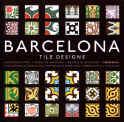 |
| Havana Tile Design and CD for graphic artists and researchers Go to Tile Books |
Barcelona Tile Designs by Mario Arturo Hernandez Navarro . Portarricense graphic designer, trained in the USA, a researcher of the hydraulic design of pavements. Go to Tile Books |
Nice Photos: http://www.mosaicoshidraulicos.com/mosaicoshidraulicos2_002.htm
Cement Tile Manufacturers Association--The CTMA is a nonprofit association comprised of concrete tile manufactures and allied product manufacturers that was formed in the late 1990's.As far as I can tell, they do not have any members making traditional encaustic concrete tiles. www.concretetile.org
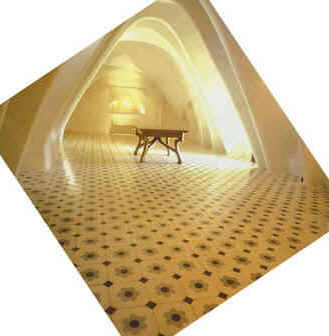

World famous Casa Batlló cement tile floors in Barcelona Spain. If you have been there, you will recognize the arched roof supports in the roomy attic area. More photos of Casa Batillo.
Floor Tile Online Design Layout Tools
Pick from hundreds of patterns and chose your colors on the Villa Lagoon Tile tile simulator tool.
Then create a layout using borders and solid colors if you like
And finally see it as a floor looks by using the humorously named "Floorify" button
The Villa Lagoon Tile creative tile design tool and layout simulator will make one click pdf's to print and each color will be identified on your printed sheets.
>5.
Mosaic Simulador Tool-you can rotate the tiles and add borders, but the selection of tiles is limited. (Internet Explorer only it seems.
>7.
This floor tile layout program is on the Argentina website companiadepisos.com design tool. You can't tessellate the individual tiles, but you can change their colors which is fun. The whole website is fun...slow but very cleverly done. www.companiadepisos.com.ar
>12.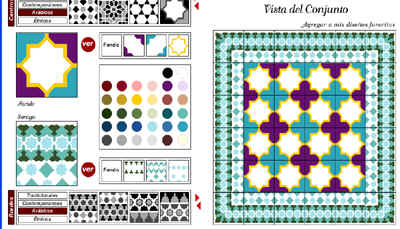
The Baldosas-Super Tile Design Tool from Chile--click the box in right hand navigation that says "Centro de Diseno"
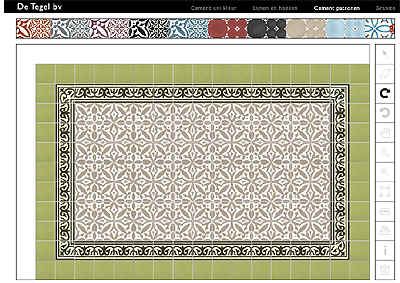
If you speak Dutch, (or install a translate toolbar button) this is a great tile floor simulator tool for you. Now two tools, Make your own tile simulator. Now make your own tile. Updated since this screen-shot was placed here. Creates a pdf of your tile design for you if you want it to.
Tile Patterns
Well designed tiles often have elements that match up whether the pattern is arranged in what I call a 'straight tiles' manner or if it is arranged in an "offset" manner. This example from a Portuguese floor tile makes illustrates.
Both of these floor tile patterns are created using this one tile:
Then offsetting in both directions gives a pattern with a missing square that could be filled in with a solid color tile. :
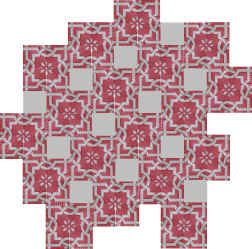

The intersecting grey lines all match up but this design would have a strong diagonal feel to it.
A similarly interlocking pattern is formed by tiles from a Portuguese company:
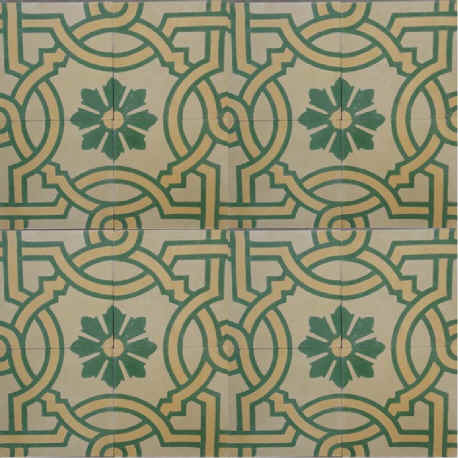

This example is created using 16 individual, identical tiles, used in 4 different directions of rotation.
Cement tiles in Paris.


I found this nice photo at http://parisconnected.wordpress.com a blog about attractions in Paris. The Passage des Princes is the latest of all the XIX century Paris covered passages. It is close to the Garnier Opéra, and is also an example of the style usually named after baron Haussmann, the Paris prefect who radically transformed the city. The passage opens in one of the Haussmannien wide straight boulevards.
More Photos of old historic cement tiles
Old French Cement Tiles Restored
Palais CampanariRestoration of some French cement tiles is described here: |
|
Fila Chemicals USA, Corp. 10800 NW 21st Strett # 170 Miami (FL) 33172 To effectively protect absorbent surfaces from oil stains, without altering the surface’s original color Fila recommends the use of FilaFob. Find a Fila Dealer |
There were some great videos of the making of hydraulic cement tile near Barcelona, Spain, but they have since been removed. Using the Google translation tool, I did an auto-translation then pasted the quasi-English version of some interesting text here. It is about the restoration work done on some historic cement tile floors:
Anyone who has visited the Solar Marquise may not have noticed that, beyond the architecture, the objects and works the floor of the house next to guard a lot of history and subtle art. The tiles of the entry of the House No. 1 are hydraulic, which is manufactured through a process of pressing craft that uses water, as the name says. "Depending on the design, the work may take months, as each ladrilho is done individually," explains Zilton Michiles, partner at Ornatos Nossa Senhora da Penha, responsible for the restoration of tiles of the house and one of only workshops in the world to make such work.
"It is a technique on which there is not much record," he explains. "There are some books, there is some information on the Internet, but who has the knowledge learned from another person who knew how. It is an art that is transmitted through generations. "
Zilton entered the business by accident. Graduated in journalism, he went to New York in the early 80 trying to work in the area (he had a friend who worked at a newspaper for Brazilians) and gain experience of life There he spent two and a half years and met Élida of Biasi, with whom he married. Meanwhile, in Sao Paulo, Élder of Biasi, his sogro, seeking a The original tiles of the Teatro Municipal (left) and House n º 1 To restore the factory floor of the two houses he owned-one in the neighborhood of Bethlehem and another in Moóca. "Almost no factories of hydraulic tiles. This, which was founded by two brothers Italians around 1908, was virtually disabled, "recalls Zilton. Élder Biasi decided to buy the factory and resume production. To assist you, drew daughter and genro and managed to bring them back to New York.
"We understood nothing of hydraulic and tiles, with the lack of literature, learn was even more difficult," says the industry."We seek the expertise to the few people who still knew the technique."
Today, the Ornatos, located in a warehouse with an office above, in the neighborhood of Penha, is one of the most in the world. Beyond the Box 1, the plant has already restored the Teatro Municipal de São Paulo, the Patio of the College, the Monastery of St. Benedict, the Palace of Catete (Rio de Janeiro, RJ), churches and homes in historic cities such as Ouro Preto ( MG) and Porto Seguro (BA) and even a castle in Amsterdam, the Netherlands. "In this castle, won the competition with traditional factories in Europe for the quality of our work."
Samples of two of the most difficult work: the left would cost $ 1,200 a square meter. Since the early 90, when he won enough space in the media for their work differently, the Ornatos eventually conquering architects and decorators, who saw the aesthetic attributes and the durability of the tiles a great material for his compositions."We ordered mainly for houses on the beach and in the interior, which have a more rustic style, sometimes even blacks. Combinam com os ladrilhos”, afirma Zilton. Match with the tiles, "says Zilton.
Prices for tiles vary with the degree of complexity to find the right colors, make the tool and do the job properly. In line trading, the Ornatos has models ranging from R $ 30 R $ 120 a square meter. For the restoration, the value ranges from R $ 50 and R $ 300.
The most difficult work of the factory was the restoration of the floor of a house in Rio de Janeiro belonging to the Department of Heritage. "The cost would be around $ 1,200 a square meter, but we charging less because, when we did the budget for the institution, we had no idea of the complexity of the work. Drawing imitava the mosaics, had many details, various colors. The difficulties have begun at the time of making the tool, "he says. The tool is the" template "of the design done in brass by a person specialized in that. He is applied on the ladrilho and craftsman will dispensing the colors in certain areas, according with the original model. "However, the order is contrary to the model, ie, the craftsman has to look at the model and enxergá it inversely to apply the color so correct. requires very eyes. The craftsman who made the tiles for this house was in trouble seríssimos of vision. "
The tools: molds made of brass by a person specialized Finding the right color, in the case of restoration, is another novel. "Based on the original models, we have to do tests, send for analysis in the laboratory, and only when it is found that the color is the one we started the work," he says. "Under the Municipal Theater, for example, were 60 days without stop tests to find the correct tone."
In addition to all these difficulties, the manufacture of tiles hydraulic has few people specialized and do not want young people learn. "We tried to train people here, but after one or two months, many drop. After all, it is a work that requires patience to east. "The factory employs six craftsmen. "One, which has ten years of experience, can make to 60 tiles per day. The most productive here to make up 120 per day, but he has 40 years of experience, "says Zilton, which says a lot done with his work. "We collaborating with the perpetuation of this process, which should take more than 400 years,"
Text from a couple's blog entry about a cement tile making place in Mexico: Love Those Floors !
"One of the first things we noticed about properties for sale here in Merida was the floors. No kidding. Because many of the floors, even in the most humble of stores or homes, are covered with beautiful mosaico tiles. These tiles are made here in Merida, based on a technology brought here from Spain centuries ago. And as far as we know, the method and many of the designs haven't changed much in the ensuing years. We had the pleasure of being invited into a small tile manufacturing company, called Pisos y Mosaicos La Peninsular, and allowed to photograph the process. We entered the old colonial building through the modest showroom, where they sell traditional mosaicos as well as new, factory-made tiles. Behind the front rooms is a large open warehouse, covered with a tin roof. Only two or three men work there in the back making the tiles on two presses, while stacks and stacks of tiles sit out to dry. The process starts with the mold. Some of the molds at this shop were made over 50 years ago, and according to the owner, the people who can make a good mold here in Merida can be counted on one hand. The owner, Ignacio, treasures his vintage molds. Molds can be made to order, or you can choose one of the old ones. You can also choose the traditional colors for a design, or order your own color scheme.
The men start by pouring a thick wet sandy concrete into a square mold. The design mold is then set on top of the concrete, and colored pottery slip (note by webmaster, it is cement, not what we think of as pottery slip) is poured into the different areas of the mold according to the design. This is all done very quickly. The package is then pressed by an old, oily, noisy hydraulic press for less than a minute, and then spit out on the other side. The end result is a 20 cm by 20 cm tile that is about an inch thick and quite heavy and costs between 80 cents and three dollars retail. One side is concrete and the other side is colored and designed. The colors at this stage are muted. The tile is carefully picked up and stacked with its brothers and left to dry for a few weeks. When it is thoroughly dry, it will be laid into a floor and then polished to bring out the bright colors. These tiles, to our surprise, are never baked or heated except by pressure.
The tiles are sometimes called "pasta tiles", perhaps for the paste-like nature of the ingredients. They are ubiquitous in the colonial homes of Merida and are one reason why these homes are so charming and attractive to renovate. Of course, if you buy a house whose tiles have been removed, (to make way for modern, white tiles, which native Yucatecans seem to think are more desirable for some reason), you can buy and install new ones.
The tiles seem to get better with age. Some of us prefer to let them mellow and get a little distressed. Others treat them specially with weekly doses of kerosene, aceite rojo and other secret ingredients to keep their tile floors polished and shiny. If you inherit a floor that looks a little worn and you want to make it new, you can hire a crew to polido (polish) the tiles.
You can see these tile floors throughout Merida in the most elegant colonial homes and in the most modest little tendejones (corner stores). They are a constant reminder of the former elegance of Merida at the beginning of the 20th Century and the very-much-alive Merida today that still has the artisans and craftsmen available to restore that elegance.
The basic procedure is about the same no matter where the tiles are made.
- The design is reproduced by a brass divider which side's walls separate the colors zones.
- The divider is inserted in a cast.
- Each space is filled with a liquid mixture of marble powder, white cement and coloring.
- The divider is retrieved, and the colored layer is rapidly covered first with dry mortar and then, with semidry mortar that will be the back of the tile.
- The mixture is compacted with a hydraulic compressor.
- The tile, that looks like a pressed semidry cookie, is taken out of the cast and carefully controlled.
- The tile is set aside for a few hours, and then immersed in water for 8 hours to complete its hydration process.
- Then they are stacked for about three weeks to allow the cement to dry and harden.
- The tiles are carefully checked before packing in cardboard boxes and ready to deliver.
The magazine, Casa e Jardim says: "Ladrilhos hidráulicos são um clássico da arquitetura de interiores."
And I agree.
Interior Design - Home and Interior Decorating The only publishing company in the United States solely focused on the interior design and home furnishings trade. Interior decor magazines, directories, books & free publications.
One type of tile that is increasingly popular is the so-called 'subway tile' ..a good source for these is www.subwaytile.biz . If you are undertaking a vintage home restoration or renovation you'll find these subway tiles a good fit.
Hidraulicos antiguos, ladrilhos hidráulicos, mosaico hidraulico, encaustic cement tiles, ladrilho de água, mosaicos cementos, hydraulic floor tile, encaustic tiles, hidraulico, hydraulic tiles, ladrilhos hidráulicos, carreaux de ciments, Spanish mission tiles, redondo tile, rajoles hidràuliques, baldosas hidráulicas, pasta potosi, hidraulicos antiguos, mosaico hidraulico, mosaicos hidralicos, mosaics de pasta, baldosas decoradas, hidráulicas de cemento, losas islenas, loseras del pais, mosaico calcareo, mosaico pictorico, loseras del cemento, hand crafted cement tile, concrete pressed tile, losera cubana, zelig, Spanish cement tile, Barcelona tile, mortar tiles, baldosas, baldosa, mosaico, pavimento...all names for the same type of floor tile.
